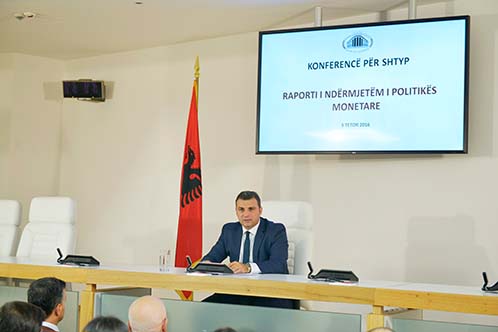BANK OF ALBANIA
PRESS RELEASE
Governor Sejko: Statement to the Press Conference on the Monetary Policy Decision of the Supervisory Council of the Bank of Albania
Publication date: 05.10.2016
The new information analysed in this monetary policy report resulted, overall, in line with our expectations. Economic activity continues to expand inflation has been upward, whereas financing costs remain around the lowest historical levels.
The new information has not changed our projections. Such projections suggest that the return of the economy to equilibrium and the firm convergence of inflation to the target will materialise only in the medium-term horizon.
Against this backdrop, the Supervisory Council judges that the current monetary policy stance is adequate. The liquid financial environment with low interest rates, dictated by the accommodative monetary policy, is necessary for boosting the further growth of economic activity and guaranteeing the return of inflation to target.

The consumer price inflation reached 2% in August, continuing on an upward trajectory, against the low values recorded in the first quarter. Inflation rates rose as a result of the increase in food and oil prices.
In macroeconomic terms, the rise in inflation reflects the effect from growth in aggregate demand and reduction of supply shocks from low food and commodity prices in global markets.
Available data suggest that the Albanian economy continued to grow during the second and third quarters, at rates comparable to the first quarter. Growth was driven by the expanded domestic demand from the private sector, whereas foreign trade and the consolidating fiscal policy contributed to the opposite side.
The favourable financial environment, growth in employment, improvement of economic agents' confidence and continuation of high inflows of foreign direct investments contributed to the increase of consumption and private investments. The Bank of Albania deems that these aggregate demand components will continue to lead economic growth in the quarters ahead.
On the other hand, the deepening deficit of foreign trade has not contributed to Albania's economic growth. This performance was mainly dictated by the increased imports, in response to the positive investment cycle in the economy. In parallel, the low foreign demand for certain typical Albanian exports for example, oil and raw materials such as minerals - decelerated our exports. The external economic environment is expected to remain unfavourable in the near term; but, the trade balance with abroad is expected to improve gradually in the medium-term horizon.
The consolidating fiscal policy was translated in budget surplus, amounting to around ALL 13.7 billion, over the first eight months of the year. The compliance with the planned levels of the budget deficit for 2016 implies that the fiscal policy will be stimulating in the rest of the year. This compliance requires also the acceleration of expenditure in the remainder of the year. The Bank of Albania deems that a more even distribution of budget expenditure throughout the year would improve their effectiveness and reduce the volatility in economic and financial indicators.
The monetary stimulus, transmitted through the lowering of the policy rate, has been already transmitted to the financial markets. These markets have been, overall, calm, although certain segments have seen added volatility. The interest rate on loans and deposits continued to stand close to their historical minimum levels throughout August. Conversely, yields on government securities have risen in the last auctions. The rise reflects a correcting trend of their rapid fall in the first half of the year, as well as temporary imbalances of demand and supply for these instruments.
Lending to the economy continues to grow, but this performance remains sluggish. Cleaned from the loan write off process in the balance sheets of the banking system and the exchange rate fluctuations, lending to the economy grew at 4.2% annually in August. The credit portfolio posted 6.9% annual growth in lek, and 2.3% in foreign currency. In sectorial terms, consumer credit performed relatively better than credit to enterprises. The slowdown of the monthly growth of the credit portfolio in July and August is expected to be a temporary phenomenon. This development, however, shows the unsteady credit performance in Albania and iterates the need for continued structural reforms, which would contribute to reducing credit risk and increasing credit demand.
Based on the available information, the Bank of Albania deems that the expected outlook for economic and financial developments, as presented in the previous quarterly report, remains valid. We foresee economic activity will progressively improve over the next two years. The improvement will contribute to the return of the economy to equilibrium over the second half of 2017, and of inflation to target over the second half of 2018. At the same time, the available information, suggests that the balance of risks in the medium-term horizon continues to remain on the down side.
Taking into account the expected fiscal consolidation, the Supervisory Council deems that the achievement of our inflation target will require adopting an accommodative monetary policy stance over this period.
In accordance with these judgments, the Supervisory Council decided to:
- keep the policy rate unchanged at 1.25%
- keep the rates for the overnight deposit and loan facilities unchanged at 0.25% and 2.25%, respectively
Furthermore, the Supervisory Council assesses that the intensity of the monetary stimulus will not diminish during 2016.
In conclusion, the Supervisory Council finds it appropriate to stress that the monetary and fiscal policies serve and are sufficient to only ensure the return of the economy to its equilibrium and maintain the economic and financial stability in Albania. On the other side, the acceleration of the economic growth potential will depend on the range and ambitiousness of the structural reform programme.

 Twitter
Twitter
 Youtube
Youtube
 Facebook
Facebook
 Flickr
Flickr
 RSS
RSS
 Subscribe
Subscribe
 Feedback
Feedback